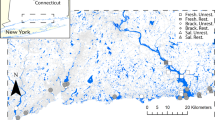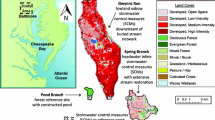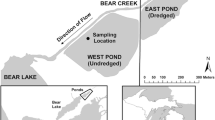Abstract
Constructed stormwater wetlands (CSWs) are used to address contaminants in urban stormwater such as nitrogen (N) and phosphorus (P), but their performance is variable. Ephemeral CSWs tend to be less effective than perennial CSWs at removing N and P. We asked: How does wetland vegetation and sediment affect nutrient cycling/release from sediment and vegetation in ephemeral CSWs? We focused on two ephemeral urban CSWs in Pocatello, ID, USA, one densely vegetated and the other nearly bare. We rewetted intact cores of dry wetland sediments and, separately, senesced vegetation for 1 week at the end of the summer dry period to assess whether wetland sediments and vegetation acted as sources or sinks of N and P. For both CSWs, there was a pulse of nutrients immediately following rewetting, but the magnitude of that pulse and subsequent changes in nutrient concentrations suggest different processes dominate at each wetland, driven by differences in wetland vegetation and associated sediment characteristics. There was evidence of denitrification between and during events at the vegetated wetland, but larger fluxes of P at this site suggests a tradeoff between denitrification and P release. While the experimental results suggested specific biogeochemical controls, CSW nutrient concentrations during three events were more dynamic and suggested more biogeochemical complexity than that represented in our experiment, both within events and seasonally. Ephemeral CSWs may create unique biogeochemical conditions and require careful design to ensure N and P retention. Managers will also need to consider whether perennial water sources would improve CSW function.





Similar content being viewed by others
References
Adyel TM, Hipsey MR, Oldham CE (2017) Temporal dynamics of stormwater nutrient attenuation of an urban constructed wetland experiencing summer low flows and macrophyte senescence. Ecol Eng 102:641–661
Adyel TM, Oldham CE, Hipsey MR (2016) Stormwater nutrient attenuation in a constructed wetland with alternating surface and subsurface flow pathways: Event to annual dynamics. Water Res 107:66–82
Athar M, Mahmood A (1985) Nodulation and nitrogen fixation by Tribulus terrestris under natural conditions. Pakistan J. Agric. Res. 6:101–106
Austin BJ, Strauss EA (2011) Nitrification and denitrification response to varying periods of desiccation and inundation in a western Kansas stream. Hydrobiologia 658:183–195
Bastviken SK, Eriksson PG, Premrov A, Tonderski K (2005) Potential denitrification in wetland sediments with different plant species detritus. Ecol Eng 25:183–190
Bechtold HA, Marcarelli AM, Baxter CV, Inouye RS (2012) Effects of N, P, and organic carbon on stream biofilm nutrient limitation and uptake in a semi-arid watershed. Limnol Oceanogr 57:1544–1554
Bettez ND, Groffman PM (2012) Denitrification potential in stormwater control structures and natural riparian zones in an urban landscape. Environ Sci Technol 46:10909–10917
Booth DT, Cox SE, Meikle TW, Fitzgerald C (2006) The accuracy of ground-cover measurements. Rangel Ecol Manag 59:179–188
Bowden WB (1987) The biogeochemistry of nitrogen in freshwater wetlands. Biogeochemistry 4:313–348
Brix H (1994) Use of constructed wetlands in water pollution control: historical development, present status, and future perspectives. Water Sci Technol 30:209–223
Cantón Y, Solé-Benet A, Domingo F (2004) Temporal and spatial patterns of soil moisture in semiarid badlands of SE Spain. J Hydrol 285:199–214
Cerezo RG, Suárez ML, Vidal-Abarca MR (2001) The performance of a multi-stage system of constructed wetlands for urban wastewater treatment in a semiarid region of SE Spain. Ecol Eng 16:501–517
Chepkwony CK, Haynes R, Swift R, Harrison R (2001) Mineralization of soil organic P induced by drying and rewetting as a source of plant-available P in limed and unlimed samples of an acid soil. Plant Soil 234:83–90
Choi JY, Maniquiz-Redillas MC, Hong JS, Lee SY, Kim LH (2015) Comparison of the treatment performance of hybrid constructed wetlands treating stormwater runoff. Water Sci Technol 72:2243–2250
Cole CA (2002) The assessment of herbaceous plant cover in wetlands as an indicator of function. Ecol Indic 2:287
DEQ (Idaho Department of Environmental Quality) (2018) Portneuf river subbasin total maximum daily load five-year review (Draft). ID: DEQ, Pocatello, ID
Duan S, Newcomer-Johnson T, Mayer P, Kaushal S (2016) Phosphorus retention in stormwater control structures across streamflow in urban and suburban watersheds. Water 8:390
Fox J, Weisberg S, Price B, Adler D, Bates D, Baud-Bovy G, Bolker B, Ellison S, Firth D, Friendly M, Gorjanc G, Graves S, Heiberger R, Laboissiere R, Maechler M, Monette G, Murdoch D, Nilsson H, Ogle D, Ripley B, Venables W, Walker S, Winsemius D, Zeileis A, R-Core (2018) car: companion to applied regression. Sage, Thousand Oaks, CA. https://socialsciences.mcmaster.ca/jfox/Books/Companion/
Gold AC, Thompson SP, Piehler MF (2019) Nitrogen cycling processes within stormwater control measures: a review and call for research. Water Res 149:578–587
Gómez Cerezo R, Suárez ML, Vidal-Abarca MR (2001) The performance of a multi-stage system of constructed wetlands for urban wastewater treatment in a semiarid region of SE Spain. Ecol Eng 16:501–517
Harrison MD, Miller AJ, Groffman PM, Mayer PM, Kaushal SS (2014) Hydrologic controls on nitrogen and phosphorous dynamics in relict oxbow wetlands adjacent to an urban restored stream. JJ Am Water Resour Assoc 50:1365–1382
Herrera J, Flamant G, Gironás J, Vera S, Bonilla CA, Bustamante W, Suárez F (2018) Using a hydrological model to simulate the performance and estimate the runoff coefficient of green roofs in semiarid climates. Water 10:198
Hobbie SE, Baker LA, Buyarski C, Nidzgorski D, Finlay JC (2014) Decomposition of tree leaf litter on pavement: implications for urban water quality. Urban Ecosyst 17:369–385
Hoffmann CC, Heiberg L, Audet J, Schønfeldt B, Fuglsang A, Kronvang B, Ovesen NB, Kjaergaard C, Hansen HCB, Jensen HS (2012) Low phosphorus release but high nitrogen removal in two restored riparian wetlands inundated with agricultural drainage water. Ecol Eng 46:75–87
Houdeshel CD, Hultine KR, Johnson NC, Pomeroy CA (2015) Evaluation of three vegetation treatments in bioretention gardens in a semi-arid climate. Landsc Urban Plan 135:62–72
Houdeshel CD, Pomeroy CA, Hultine KR (2012) Bioretention design for xeric climates based on ecological principles. J Am Water Resour Assoc 48:1178–1190
Jahangir MMR, Richards KG, Healy MG, Gill L, Müller C, Johnston P, Fenton O (2016) Carbon and nitrogen dynamics and greenhouse gas emissions in constructed wetlands treating wastewater: a review. Hydrol Earth Syst Sci 20:109–123
Janzen B (2009) Annual and seasonal fluctuations in species composition of sagebrush steppe in response to experimental manipulations of precipitation and soil profiles. Idaho State University, M.S. Thesis, Pocatello, ID
Kadlec RH (2016) Large constructed wetlands for phosphorus control: a review. Water 8:243
Kadlec RH, Reddy KR (2001) Temperature effects in treatment wetlands. Water Environ Res 73:543–557
Kadlec, RH, Wallace S (2008) Treatment wetlands. CRC Press, Boca Raton, FL
Kalbitz K, Solinger S, Park J-H, Michalzik B, Matzner E (2000) Controls on the dynamics of dissolved organic matter in soils: a review. Soil Sci 165:277
Kieckbusch JJ, Schrautzer J (2007) Nitrogen and phosphorus dynamics of a re-wetted shallow-flooded peatland. Sci Total Environ 380:3–12
Kinsman-Costello LE, Hamilton SK, O’Brien JM, Lennon JT (2016) Phosphorus release from the drying and reflooding of diverse shallow sediments. Biogeochemistry 130:159–176
Koch BJ, Febria CM, Gevrey M, Wainger LA, Palmer MA (2014) Nitrogen removal by stormwater management structures: a data synthesis. J Am Water Resour Assoc 50:1594–1607
Kröger R, Holland MM, Moore MT, Cooper CM (2007) Plant senescence: a mechanism for nutrient release in temperate agricultural wetlands. Environ Pollut 146:114–119
Land M, Granéli W, Grimvall A, Hoffmann CC, Mitsch WJ, Tonderski KS, Verhoeven JTA (2016) How effective are created or restored freshwater wetlands for nitrogen and phosphorus removal? A systematic review. Environ Evid 5:9
Loeb R, Lamers LPM, Roelofs JGM (2008) Effects of winter versus summer flooding and subsequent desiccation on soil chemistry in a riverine hay meadow. Geoderma 145:84–90
Marcarelli AM, Bechtold HA, Rugenski AT, Inouye RS (2009) Nutrient limitation of biofilm biomass and metabolism in the Upper Snake River basin, southeast Idaho, USA. Hydrobiologia 620:63–76
McLaughlin C (2008) Evaporation as a nutrient retention mechanism at Sycamore Creek, Arizona. Hydrobiologia 603:241–252
Meyer JL, Paul MJ, Taulbee WK (2005) Stream ecosystem function in urbanizing landscapes. J N Am Benthological Soc 24:602–612
Moreno D, Pedrocchi C, Comín FA, García M, Cabezas A (2007) Creating wetlands for the improvement of water quality and landscape restoration in semi-arid zones degraded by intensive agricultural use. Ecol Eng 30:103–111
Mulholland PJ, Helton AM, Poole GC, Hall RO, Hamilton SK, Peterson BJ, Tank JL, Ashkenas LR, Cooper LW, Dahm CN, Dodds WK, Findlay SEG, Gregory SV, Grimm NB, Johnson SL, McDowell WH, Meyer JL, Valett HM, Webster JR, Arango CP, Beaulieu JJ, Bernot MJ, Burgin AJ, Crenshaw CL, Johnson LT, Niederlehner BR, O’Brien JM, Potter JD, Sheibley RW, Sobota DJ, Thomas SM (2008) Stream denitrification across biomes and its response to anthropogenic nitrate loading. Nature 452:202–205
Newcomer Johnson TA, Kaushal SS, Mayer PM, Smith RM, Sivirichi GM (2016) Nutrient retention in restored streams and rivers: a global review and synthesis. Water 8:116
Olila OG, Reddy KR, Stites DL (1997) Influence of draining on soil phosphorus forms and distribution in a constructed wetland. Ecol Eng 9:157–169
Pan X, Ping Y, Cui L, Li W, Zhang X, Zhou J, Yu F-H, Prinzing A (2017) Plant litter submergence affects the water quality of a constructed wetland. PLoS ONE 12:e0171019
Paul EA (2014) Soil microbiology, ecology and biochemistry. Academic Press, San Diego, CA
Payne EGI, Fletcher TD, Russell DG, Grace MR, Cavagnaro TR, Evrard V, Deletic A, Hatt BE, Cook PLM (2014) Temporary storage or permanent removal? The division of nitrogen between biotic assimilation and denitrification in stormwater biofiltration systems. PLOS ONE 9:e90890
Qiu S, McComb AJ (1995) Planktonic and microbial contributions to phosphorus release from fresh and air-dried sediments. Mar Freshw Res 46:1039–1045
Rasband, WS, Image J U.S. (1997–2018) National Institutes of Health, Bethesda, Maryland, USA. https://imagej.nih.gov/ij/
Rejmánková E, Sirová D, Castle ST, Bárta J, Carpenter H (2018) Heterotrophic N2-fixation contributes to nitrogen economy of a common wetland sedge, Schoenoplectus californicus. PLOS ONE 13:e0195570
Robertson JJ, Fletcher TD, Danger A, Szota C (2018) Identifying critical inundation thresholds to maintain vegetation cover in stormwater treatment wetlands. Ecol Eng 116:80–86
von Schiller D, Acuña V, Graeber D, Martí E, Ribot M, Sabater S, Timoner X, Tockner K (2011) Contraction, fragmentation and expansion dynamics determine nutrient availability in a Mediterranean forest stream. Aquat Sci 73:485
Schimel J, Balser TC, Wallenstein M (2007) Microbial stress-response physiology and its implications for ecosystem function. Ecology 88:1386–1394
Schönbrunner IM, Preiner S, Hein T (2012) Impact of drying and re-flooding of sediment on phosphorus dynamics of river-floodplain systems. Sci Total Environ 432:329–337
Shumilova O, Zak D, Datry T, von Schiller D, Corti R, Foulquier A, Obrador B, Tockner K, Allan DC, Altermatt F, Arce MI, Arnon S, Banas D, Banegas‐Medina A, Beller E, Blanchette ML, Blanco-Libreros JF, Blessing J, Boëchat IG, Boersma K, Bogan MT, Bonada N, Bond NR, Brintrup K, Bruder A, Burrows R, Cancellario T, Carlson SM, Cauvy-Fraunié S, Cid N, de Danger M, Terra BF, Girolamo AMD, del Campo R, Dyer F, Elosegi A, Faye E, Febria C, Figueroa R, Four B, Gessner MO, Gnohossou P, Cerezo RG, Gomez-Gener L, Graça MAS, Guareschi S, Gücker B, Hwan JL, Kubheka S, Langhans SD, Leigh C, Little CJ, Lorenz S, Marshall J, McIntosh A, Mendoza‐Lera C, Meyer EI, Miliša M, Mlambo MC, Moleón M, Negus P, Niyogi D, Papatheodoulou A, Pardo I, Paril P, Pešić V, Rodriguez-Lozano P, Rolls RJ, Sanchez‐Montoya MM, Savić A, Steward A, Stubbington R, Taleb A, Vorste RV, Waltham N, Zoppini A, Zarfl C (2019) Simulating rewetting events in intermittent rivers and ephemeral streams: a global analysis of leached nutrients and organic matter. Global Change Biol. 25(5):1591–1611
Smith VH, Joye SB, Howarth RW (2006) Eutrophication of freshwater and marine ecosystems. Limnol Oceanogr 51:351–355
Spieles DJ, Mitsch WJ (1999) The effects of season and hydrologic and chemical loading on nitrate retention in constructed wetlands: a comparison of low-and high-nutrient riverine systems. Ecol Eng 14:77–91
Srivastava J, Gupta A, Chandra H (2008) Managing water quality with aquatic macrophytes. Rev Environ Sci Biotechnol 7:255–266
Tjepkema JD, Evans HJ (1976) Nitrogen fixation associated withJuncus balticus and other plants of oregon wetlands. Soil Biol Biochem 8:505–509
U.S. Census Bureau (2016) QuickFacts: Pocatello, Idaho. www.census.gov/quickfacts/table/RHI105210/1664090
Vymazal J (2007) Removal of nutrients in various types of constructed wetlands. Sci Total Environ 380:48–65
Walsh CJ, Roy AH, Feminella JW, Cottingham PD, Groffman PM, Morgan II RP (2005) The urban stream syndrome: current knowledge and the search for a cure. J N Am Benthol Soc 24:706–723
Weisner SE, Eriksson PG, Granéli W, Leonardson L (1994) Influence of macrophytes on nitrate removal in wetlands. Ambio 23:363–366
Weller NA, Childers DL, Turnbull L, Upham RF (2016) Aridland constructed treatment wetlands I: macrophyte productivity, community composition, and nitrogen uptake. Ecol Eng 97:649–657
Werker AG, Dougherty JM, McHenry JL, Van Loon WA (2002) Treatment variability for wetland wastewater treatment design in cold climates. Ecol Eng 19:1–11
Acknowledgements
This work was supported by NSF EPSCoR grant IIA 1301792 as part of the Idaho EPSCoR Program. We thank the City of Pocatello for allowing the sampling and instrumentation of the studied sites, and particularly Hannah Sanger, whose interest sparked this project and who has been helpful and supportive from the project’s infancy. Dr. Keith Reinhardt provided both equipment and technical advice critical to the vegetation components to this project. Sarah Stalder, Sophie Hill, Alyssa Millard, Zach Fishburn, Kyndra Hawkes, and James Guthrie all provided valuable field and lab assistance.
Author information
Authors and Affiliations
Corresponding author
Ethics declarations
Conflict of Interest
The authors declare that they have no conflict of interest.
Additional information
Publisher’s note Springer Nature remains neutral with regard to jurisdictional claims in published maps and institutional affiliations.
Rights and permissions
About this article
Cite this article
Macek, C.L., Hale, R.L. & Baxter, C.V. Dry Wetlands: Nutrient Dynamics in Ephemeral Constructed Stormwater Wetlands. Environmental Management 65, 32–45 (2020). https://doi.org/10.1007/s00267-019-01227-x
Received:
Accepted:
Published:
Issue Date:
DOI: https://doi.org/10.1007/s00267-019-01227-x




